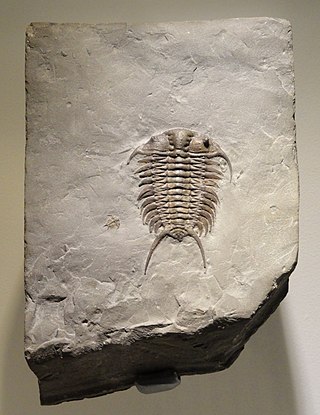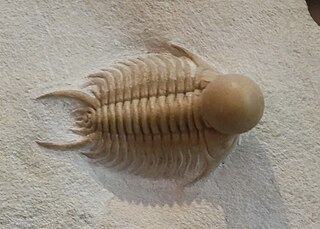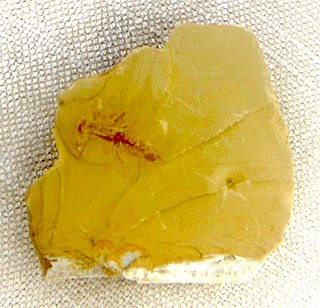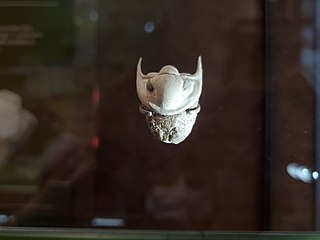
Ptychopariida is a large, heterogeneous order of trilobite containing some of the most primitive species known. The earliest species occurred in the second half of the Lower Cambrian, and the last species did not survive the Ordovician–Silurian extinction event.

Ceraurus is a genus of cheirurid trilobite of the middle and, much more rarely, the upper Ordovician. They are commonly found in strata of the lower Great Lakes region. These trilobites have eleven thoracic segments, a very small pygidium and long genal and pygidial spines.
Eophacops is a genus of trilobites from the order Phacopida, family Phacopidae. These trilobites lived during the Middle Silurian in what are now North America and North-West Europe. Species assigned to this genus can be distinguished from Phacops by their small size (2–3 cm). Eophacops has very large eyes compared to the rest of its body.

Encrinurus is a long-lived genus of phacopid trilobites that lived in what are now Africa, Asia, Australia, Europe, North America, and South America from the middle Ordovician to the early Devonian from 472 to 412.3 mya, existing for approximately 59.7 million years.

Leonaspis is a widespread genus of odontopleurid trilobite that lived from the Late Ordovician to the late Middle Devonian. Fossils of various species have been found on all continents except Antarctica.

Sphaerocoryphe is a genus of trilobite that lived from the middle Ordovician to the Silurian. Its fossils have been found in Australia, Europe, and North America. Both Sphaerocoryphe and Hemisphaerocoryphe had a characteristically bulbous glabella, and the two may represent only one genus.

Cheirurus is a genus of phacopid trilobites that lived from the Ordovician to the Devonian. Its remains have been found in Africa, Asia, Australia, Europe, and North America. Cheirurus is the type genus of Cheiruridae.
Bainella is an extinct genus of Devonian trilobites from off the coast of Gondwana. Fossils were found in the Ponta Grossa Formation of Brazil, Belén, Icla and Gamoneda Formations of Bolivia and the Gydo, Gamka and Voorstehoek Formations of South Africa. It contains three species: B. africana, B. baini, and B. cristagalli.
Deltacephalaspis is an extinct genus of trilobites in the order Phacopida. It contains four species, D. comis, D. magister, D. retrospina, and D. tumida. Fossils of the genus have been found in the Belén, Icla and Gamoneda Formations of Bolivia and the Gydo Formation of South Africa.

Encrinuroides is a genus of trilobites in the order Phacopida, that existed during the upper Ordovician in what is now Wales. It was described by Reed in 1931, and the type species is Encrinuroides sexcostata, which was originally described under the genus Cybele by Salter in 1848. It also contains the species, Encrinuroides enshiensis, Encrinuroides insularis, and Encrinuroides rarus. The type locality was in the Sholeshook Limestone Formation.

Cindarella is genus of trilobite-like Cambrian arthropod known from the Chengjiang biota of China. It is classified in the stem group of trilobites (Artiopoda) in the clade Xandarellida, along with Phytophilaspis, Sinoburius, and Xandarella.
Remopleurides is an extinct genus of trilobites.

Harpides is an extinct genus of harpetid trilobite of the family Harpididae.

Illaenus is a genus of trilobites from Russia and Morocco, from the middle Ordovician.

Proetus is a genus of proetid trilobite found in Silurian-aged marine strata of Europe.

Paladin is a genus of trilobite which lived 354–259 Ma, during the Late Paleozoic era; more specifically, during the Carboniferous and Permian periods. It was widespread: fossils have been discovered in what are now East Asia, Europe and North America.
Calodiscus is a genus of Eodiscinid trilobite in the family Calodiscidae. It lived during the late Lower Cambrian, with remains found in Canada, the United States, Greenland, The United Kingdom (England), Sweden, France, Germany, Italy (Sardinia), Kazakhstan, the Russian Federation and China.

Ditomopyge is an extinct genus of trilobite belonging to the family Proetidae. It was extant during the Carboniferous and Permian and is widely distributed, with fossils found in Europe, southwest Asia, southeast Asia, Australia, North America, and South America.

Ameura is an extinct genus of trilobite belonging to the family Proetidae. Fossils from the genus have been found in late Paleozoic beds in North America.

Pseudophillipsia is a genus of trilobite, notable for being one of the last members of the group before the extinction at the end of the Permian. It first appeared during the Pennsylvanian or Late Carboniferous. There are several species and this genus has a range spanning Eurasia.














